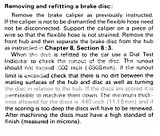While I am waiting for insurance stuff to get cleared, I am working on the front brakes. Took my rotors into Les Schwab to get turned, but they said they can't find any specs for my brakes. Does anyone know what the minimum thickness that the rotors can be turned? They specifically asked for "minimum machine two" not sure what that means totallly. Nothing in either my Haynes or Bentley seems to state this that I can see. Any help would be appreciated.
Kevin
Kevin

 Hi Guest!
Hi Guest!

 smilie in place of the real @
smilie in place of the real @
 Pretty Please - add it to our Events forum(s) and add to the calendar! >>
Pretty Please - add it to our Events forum(s) and add to the calendar! >> 

